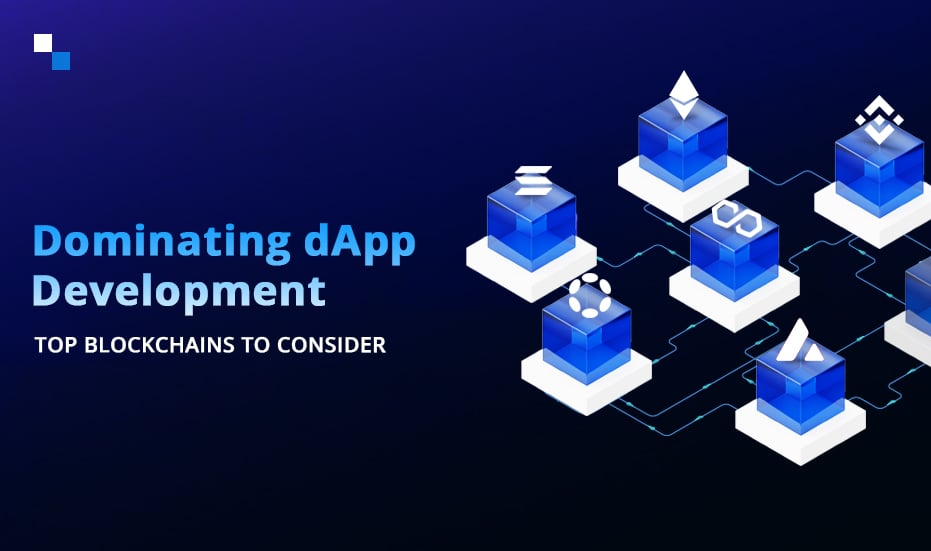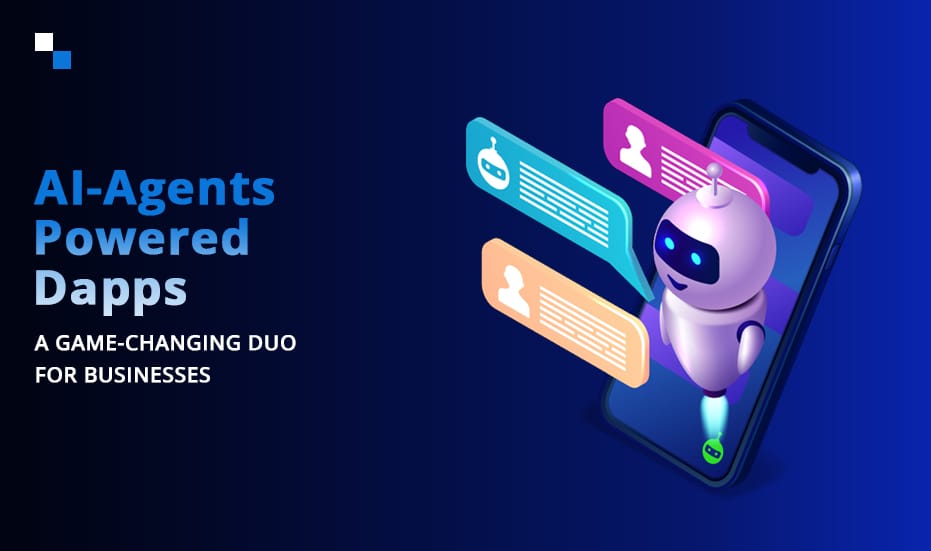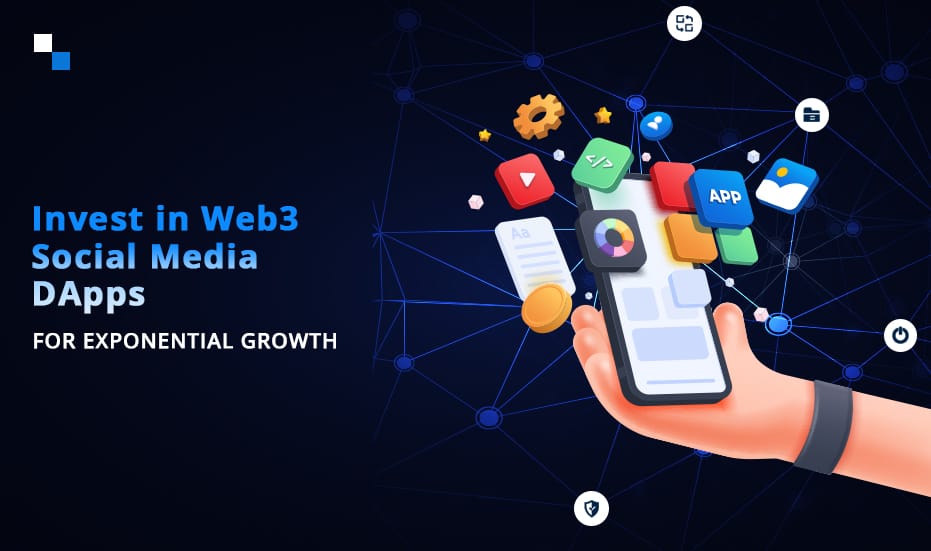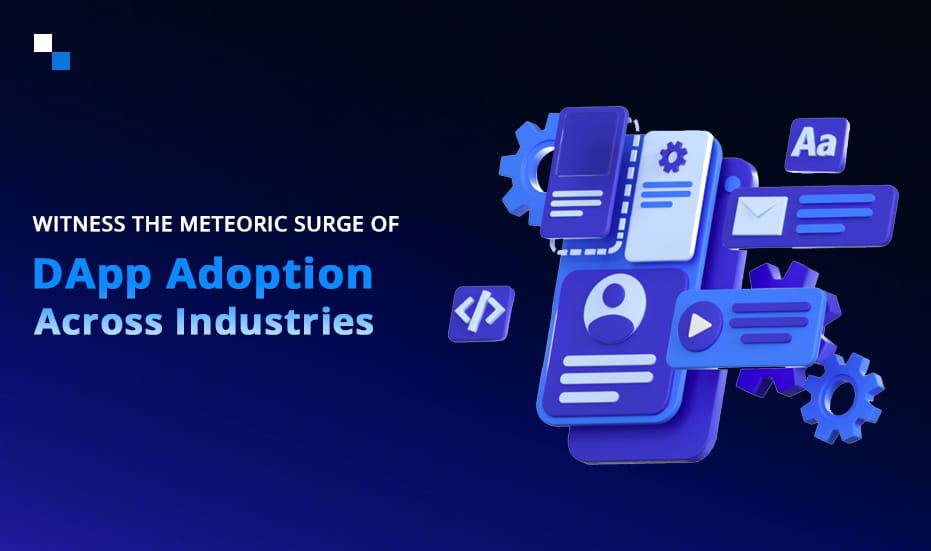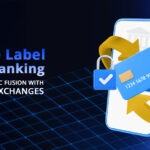
Why Invest In White Label Neo Bank With Crypto Exchange in 2025?
December 19, 2024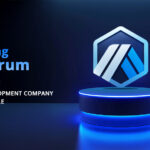
How to Develop a Token on Arbitrum?
December 20, 2024Table of Contents:
- Introduction
- The Dawn of Decentralization: A Brief Market Overview
- Charting the Course: Key Considerations For Choosing a Blockchain for dApp Development
- A Visual Representation of How dApps Work
- Top 10 Blockchain Titans for dApp Development in 2025
- Real-World Impact: Common dApp Use Cases That Will Shape the Future
- Looking Ahead: What Does the Future Hold for Blockchain dApps?
Introduction
In the words of Vitalik Buterin, co-founder of Ethereum, “The future of finance is decentralized.” This sentiment echoes not only across the cryptocurrency landscape but industries worldwide as they seek to harness the power of dApps to instill unparalleled security, transparency, and user control into conventional processes. These game-changers offer a glimpse into a future where control isn’t monopolized by centralized authorities.
It is crucial to choose the right blockchain platform and dApp development company for building an innovative blockchain application. Let’s explore how businesses across finance, gaming, healthcare, supply chain, and other industries can navigate the blockchain maze and build domineering dApps.
The Dawn of Decentralization: A Brief Market Overview
“In Q3 2024, the dApps surged by 70% (QoQ) with daily Unique Active Wallets reaching 17.2 million.” Source: dappradar
The third quarter of 2024 witnessed a historic surge in blockchain dApp development and activity with AI-powered applications leading the charge. DeFi, games, and NFTs were the other rising stars that followed the upward trajectory and consequenced the meteoric rise. As of 18 December 2024, over 21,358 dApps are running over 75 blockchains, and the top 4 chains including BNB smart chain, Ethereum, Polygon, and Tron host the largest number of applications. A renowned resource identified only 12,000 active dApps by the end of 2023. Such a huge leap in the past year demonstrates nothing less than a prosperous future and mainstream adoption of decentralized applications and technologies.
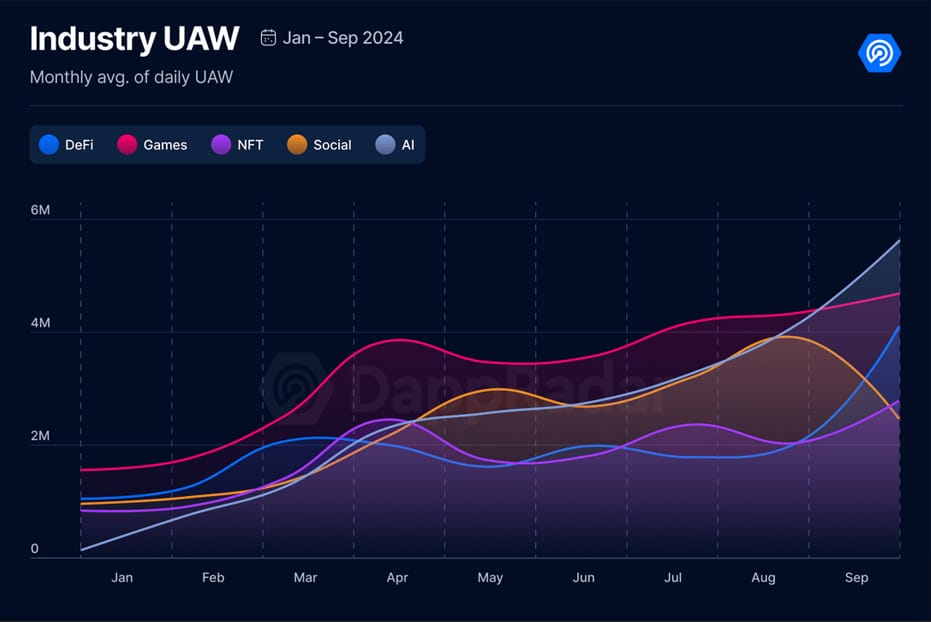
Source: DappRadar
Businesses can tap into the surge in interest for dApps by partnering with a pioneering dApp development services provider. But before expanding into the space, they must first crack the blockchain maze and choose the right blockchain for their needs. Let’s now explore key factors to evaluate when selecting a platform for your dApp:
Charting the Course: Key Considerations For Choosing a Blockchain for dApp Development
“The right blockchain platform isn’t just about technology; it’s about understanding your project’s specific needs.”
Selecting a blockchain platform for your blockchain dApp development is not a one-size-fits-all situation. The choice depends on several key factors that can determine the success of your application. Before selecting your dApp development company, it is one of the crucial choices for your project.
Here’s a breakdown of what you need to keep in mind:
- Scalability: Can the blockchain handle a high number of transactions per second without compromising performance? Can the platform be scaled by leveraging layer 2, sharding solutions, sidechains, etc.?
- Transaction speed: Some HFT or gaming applications might require speedy, frequent transactions. Is the speed and transaction throughput facilitated by a blockchain protocol suitable for your dApp development use case?
- Security: How secure is the blockchain? Does it have robust consensus mechanisms to resist attacks and ensure the integrity of user funds and assets? Is the platform fortified with extensive security measures to fight against smart contracts, Sybil, and other popular attacks?
- Transaction Costs: What costs are associated with the transaction and smart contract execution on the blockchain network chosen for your blockchain dApp development? Are the transaction fees affordable and competitive? What are gas fees, node hosting, and data storage-related expenses?
- Governance: Does the blockchain have a decentralized governance model? How are upgrades and protocol changes handled?
- Developer-Friendliness and Community Support: A strong, active community offering a wealth of libraries, frameworks, third-party integrations, and rich toolsets can effectively speed up the dApp development process and reduce roadblocks. Is the platform easy to learn and develop? Does the platform have robust developer tools including IDEs, SDKs, APIs, and testing environments to simplify coding, maintenance, and deployment??
- Interoperability: Interoperability enhances functionality and user experience. Can your dApp communicate seamlessly with other blockchains or traditional systems if deployed on a certain blockchain network? Is the blockchain integrated with relay chains and hubs to facilitate seamless exchange across different protocols? Is the dApp development protocol compatible with various cross-chain bridges?
A Visual Representation of How dApps Work
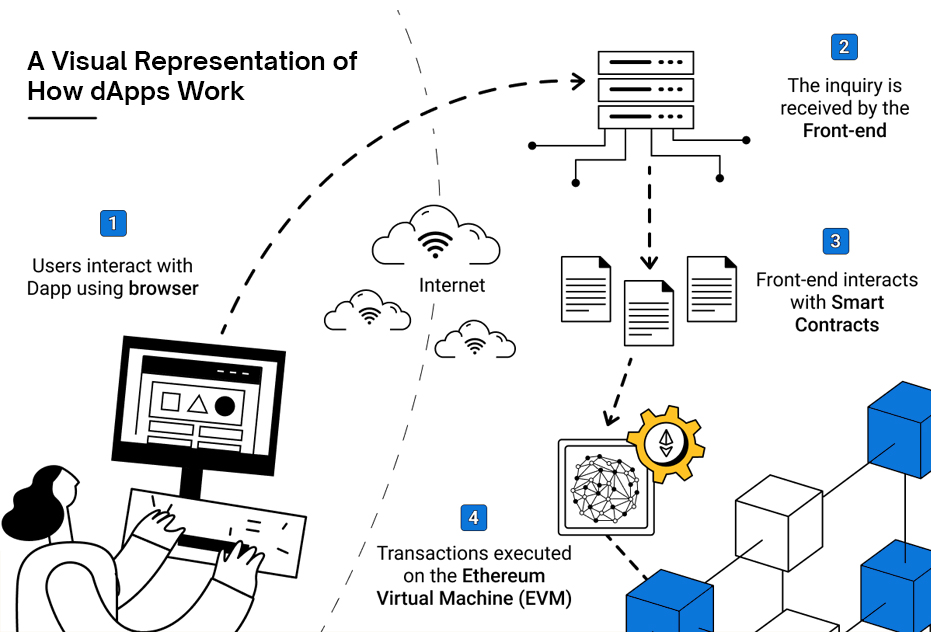
Source: Etherscan
Top 10 Blockchain Titans for dApp Development in 2025
In 2025, several blockchain platforms are pushing the boundaries of decentralized application development. So, before you finally talk to your Decentralized App development services provider regarding your DeFi dream, you must carefully study the top titans of the blockchain space.
Here’s a curated list of the leading platforms:
1. Binance Smart Chain: Fast, Economical and Developer-Friendly
- Compared to Ethereum, the Proof of Staked Authority (PoSA) based high-performance blockchain platform facilitates faster transaction speeds and lower fees, making it a preferred choice for most dApp development services providers.
- A large and active community supports BSC’s growth and development. The vibrant and rapidly growing ecosystem of dApps and DeFi projects is supported by Binance’s extensive resources and network.
- Apart from the features mentioned above, BSC’s support for DeFi development and EVM compatibility makes it a top contender for most decentralized application use-cases. The Ethereum compatibility allows projects to seamlessly integrate with or be migrated to ethereum’s ecosystem.
- Ideal Use Cases: Cost-effective DeFi projects, NFT marketplaces, projects that need to migrate from Ethereum or integrate with its vast ecosystem, etc.
- Challenges: Centralization concerns, less mature ecosystem compared to Ethereum, regulatory risks, security risks, etc.
2. Ethereum 2.0: The OG With Established Ecosystem and Extensive Tools
- Ethereum remains at the forefront of blockchain dApp development with a vast ecosystem of developers and tools.
- With its transition to Ethereum 2.0, the network has significantly improved its scalability and energy efficiency. The introduction of Proof of Stake (PoS) over Proof of Work (PoW) aims to make Ethereum more sustainable while keeping it highly secure.
- The decentralized, open-source blockchain’s robust smart contract capabilities enable complex blockchain dApp development for industries ranging from finance to games.
- Ideal Use Cases: Finance and DeFi, NFTs, governance, gaming, complex applications.
- Challenges: High transaction fees, scalability issues, network complexity
3. Solana: The Speed Demon Demonstrating Cost-Efficiency
- Known for its ultra-fast, low-cost transactions, Solana has carved a niche in the blockchain world.
- With its unique combination of Proof of History and Proof of Stake consensus mechanism, it promises efficient scaling and transaction processing at breakneck speeds (65,000 TPS), making it a favorite for high-performance. blockchain dApp development.
- The leading blockchain network is rapidly growing with numerous promising DeFi projects on their pre-launch phase.
- Ideal Use Cases: Gaming, finance, supply chain.
- Challenges: Centralization concerns, smaller community, occasional network outages, complex consensus structure, evolving ecosystem.
4. Polygon: Ethereum’s Scalability Solution
- Known as the “Ethereum’s Internet of Blockchains,” Polygon has emerged as a leading solution addressing Ethereum scalability limitations.
- Polygon’s interoperability with Ethereum ensures seamless integration with existing dApps. Fortified with a suite of interoperable protocols, the ethereum scaling solution offers a scalable and secure dApp development platform for developers to build high performance applications.
- Polygon offers various scaling solutions, including Plasma, zkRollups, and Optimistic Rollups, significantly improving transaction speeds and reducing gas fees.
- The thriving ecosystem with a rapidly growing number of dApps, DeFi protocols provides a robust and developer-friendly environment with a wide range of tools and resources.
- Ideal Use Cases: DeFi and blockchain dApp development, enterprise solutions, metaverse development, NFTs, gaming, etc.
- Challenges: Security and Decentralization
5. Polkadot: A Multi-Chain Ecosystem for Interoperability
- Polkadot’s vision of creating a web where different blockchains can interact seamlessly is gaining momentum. Its multi-chain framework allows developers to create dApps that can communicate across various networks, promoting interoperability and collaboration.
- The dApp development platform works collaboratively with parachains, boosting overall scalability and performance.
- The shared security model where all parachains benefit from security of relay chain scales up the security of the platform.
- The governance model where stakeholders vote on protocol upgrade is a stand-out advantage of the
- Ideal Use Cases: Cross-chain applications, decentralized governance, supply chain.
- Challenges: Complexity, evolving ecosystem, dApp development costs, integration challenges
6. Avalanche: High Throughput and Fast Finality
- Avalanche can process thousands of transactions per second, making it a highly scalable solution.
- By using a unique consensus-based on snowman protocol, Avalanche guarantees that transactions are finalized in under 1 second, ensuring that dApps on its network run smoothly and swiftly.
- The highly interoperable blockchain ecoystem is designed to facilitate low-cost transactions, making it an attractive choice for users and developers.
- With highly energy-efficient and sustainable consensus mechanism and an expanding ecosystem of dApps, DeFi projects, and enterprise applications, it becomes an incredible solution for dApp development.
- Ideal Use Cases: DeFi, enterprise solutions, asset tokenization.
- Challenges: Complexity, immature ecosystem, centralization concerns.
7. TON: The Visionary Beyond Blockchain
- The blockchain network originating from Telegram’s team is designed to bring Web2 apps to Web3 through a swift, scalable, and user-friendly blockchain solution.
- The highly scalable solution, capable of handling millions of transactions per second, is built to attract non-technical users to the blockchain.
- Through sharding mechanisms, the blockchain dApp development network optimizes the scalability and performance, allowing transactions to be processed in parallel. Robust security features and decentralized storage systems ensure the integrity of user data and assets on the blockchain.
- Ideal Use Cases: Social media integration, highly scalable needs
- Challenges: Underdeveloped ecosystem, regulatory challenges, complexities
8. SUI: An Emerging Performer
- SUI is known for its high-performance and object-centric design. The blockchain dApp development solution prioritizes speed, scalability, and user experience.
- SUI treats data as individual objects, each with its owner. This allows for parallel transaction processing, significantly increasing throughput.
- SUI uses the Move programming language, designed with security and formal verification in mind. It helps prevent common smart contract vulnerabilities like reentrancy attacks.
- SUI uses a variant of the Narwhal and Tusk consensus mechanisms, which provide fast transaction finality, meaning transactions are confirmed quickly and irreversibly.
- Ideal Use Cases: High-performance applications, DeFi, gaming, and NFTs.
- Challenges: Limited blockchain ecosystem, network stability issues, scalability limitations
9. OP-Stack: The Modular Innovator
- Op-Stack is a modular and customizable Layer 2 solution built on the Optimism network to enhance the scalability and utility of the Ethereum network. It leverages optimistic rollups that bundle multiple transactions into batches and process them off-chain to attain low gas fees and improved transaction throughput.
- Its compatibility and inherited security from the Ethereum mainnet make it suitable for blockchain dApp development.
- Ideal Use Cases: Ethereum dApps, cost-sensitive applications suitable for enterprises, and other organizations looking for a tailored Layer 2 solution.
- Challenges: Compatibility issues, withdrawal delays, evolving ecosystem, adoption rates, centralization risks, security and reliability issues, with custom rollups.
10. Arbitrium Orbit: The interoperable hub
- Arbitrum Orbit is another layer-2 dApp development solution from Offchain Labs developed to address Ethereum’s scalability limitations. It leverages optimistic rollups to enhance scalability, reduce transaction costs, and enhance transaction speeds.
- The network works seamlessly with Ethereum-based dApps and facilitates seamless communication and asset transfers between rollups. Like Optimism, it inherits Ethereum’s robust security
- Arbitrium’s vast library of developer tools and resources supports complex blockchain dApp development and deployment.
- Ideal Use Cases: Suitable for cross-rollup communication, inventive DeFi, and gaming applications, ethereum-based projects, etc.
- Challenges: Ensuring secure and efficient inter-rollup communication, withdrawal delays, complexity, adoption rates, centralization risks, and privacy issues.
Real-World Impact: Common dApp Use Cases That Will Shape the Future
“Blockchain dApps are not just tools—they’re empowering people with control, ownership, and opportunities that traditional systems can’t offer.”
As blockchain technology matures, the range of dApp development use cases continues to expand. Here are some areas where dApps are already making significant strides:
- DeFi: dApps are at the heart of DeFi protocols, offering users financial services without the need for banks or intermediaries. Examples include lending, borrowing, trading, yield farming, and other financial services.
- Supply Chain Management: Blockchain dApp development is revolutionizing transparency in supply chains, allowing consumers to track the journey of products from creation to consumption. Platforms like VeChain utilize blockchain for transparent tracking of goods from production to delivery.
- NFTs: Creators and collectors are using blockchain to mint, trade, and showcase NFTs—digital assets that represent ownership of unique items or content.
- Gaming: Blockchain gaming dApp development has taken off, with players owning in-game assets and engaging in peer-to-peer transactions. Games such as Star Atlas on Solana leverage blockchain technology to create immersive experiences with true ownership of in-game assets.
- Social Media: Decentralized social networks aim to give users control over their data while fostering community engagement.
- Governance: Decentralized autonomous organizations enable token holders to vote on decisions, creating decentralized governance structures for various projects and communities.
Looking Ahead: What Does the Future Hold for Blockchain dApp Development?
As we move into 2025, blockchain’s role in powering decentralized applications will only grow stronger. The key to the future of dApps lies in their scalability, interoperability, and user experience. While blockchain platforms like BSC, Ethereum, Solana, SUI, Solana, Polygon and Polkadot will continue to lead the charge, innovation will be driven by the more interoperable and user-friendly blockchain dApp development.
What’s Next?
- Cross-Platform Interoperability: We’ll see a rise in the use of cross-chain bridges, making it easier for dApps to operate across multiple blockchain ecosystems.
- Improved UX/UI: As dApp adoption increases, user experience will become paramount, with interfaces that rival traditional applications.
- Integration with Traditional Systems: More traditional industries will adopt dApp development for back-office operations, financial services, and governance.
“The true potential of blockchain dApps lies in how they transform industries—unlocking efficiencies, trust, and accessibility in ways we’ve only begun to explore.”
In conclusion, 2025 will mark the rise of more robust and specialized platforms for dApp development. With blockchain technologies evolving rapidly, developers now have access to a rich ecosystem of tools that can help them create the next wave of revolutionary decentralized applications. As the technology matures, we are likely to see even more disruptive innovations that further decentralize power, empower users, and reshape industries.
The future is decentralized. The future is now.
As we journey into the future, the possibilities for dApps are limitless. Let’s embrace the power of decentralization and create a more equitable and transparent digital world. Share your blockchain dApp development requirements right away!
